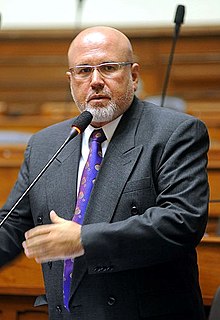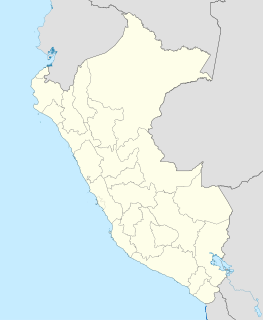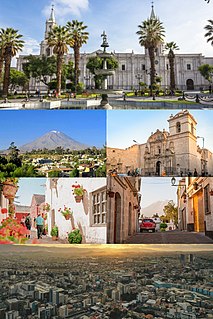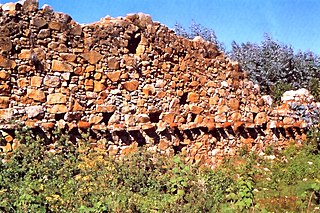Related Research Articles

Peru, officially the Republic of Peru, is a country in western South America. It is bordered in the north by Ecuador and Colombia, in the east by Brazil, in the southeast by Bolivia, in the south by Chile, and in the south and west by the Pacific Ocean. Peru is a megadiverse country with habitats ranging from the arid plains of the Pacific coastal region in the west to the peaks of the Andes mountains extending from the north to the southeast of the country to the tropical Amazon Basin rainforest in the east with the Amazon river. At 1.28 million km2, Peru is the 19th largest country in the world, and the third largest in South America.

Cuzco, also spelled Cusco, is a department and region in Peru and is the fourth largest department in the country, after Madre de Dios, Ucayali, and Loreto. It borders the departments of Ucayali on the north; Madre de Dios and Puno on the east; Arequipa on the south; and Apurímac, Ayacucho and Junín on the west. Its capital is Cusco, the historical capital of the Inca Empire.

The Society of Mary, a Roman Catholic Marian Society, is a congregation of brothers and priests called the Marianists or Marianist Brothers and Priests. The society was founded by William Joseph Chaminade, a priest who survived the anti-clerical persecution during the French Revolution. The society is one of the four branches of the Marianist Family. Along with the other branches, the Marianist Brothers and Priests look to Mary as a model of faith and spirituality. They believe that the best ways to live a spiritual life are to share their faith with others, work with the poor, and educate and nourish the mind, the body, and the soul.

Huancavelica or Wankawilka in Quechua is a city in Peru. It is the capital of the department of Huancavelica and according to the 2017 census had a population of 49,570 people. The city was established on August 5, 1572 by the Viceroy of Peru Francisco de Toledo. Indigenous peoples represent a major percentage of the population. It has an approximate altitude of 3,676 meters; the climate is cold and dry between the months of February and August with a rainy season between September and January. It is considered one of the poorest cities in Peru.

Carlos Ricardo Bruce Montes de Oca is a Peruvian politician and a former Congressman, representing Lima from 2006 until 2019, when his term ended with the dissolution of the Congress by Martín Vizcarra in 2019.
Peruvians are people identified with the country of Peru. There were Andean and Coastal Ancient civilizations like Caral, the oldest civilization of Peru and the Americas, who inhabited Peruvian territory for several millennia before the Spanish Conquest in the 16th century; Peruvian population decreased from an estimated 5–9 million in the 1520s to around 600,000 in 1620 mainly because of infectious diseases. Spaniards and Africans arrived in large numbers in 1532 under colonial rule, mixing widely with each other and with Native Peruvians. During the Republic, there has been a gradual immigration of European people. Chinese and Japanese arrived in large numbers at the end of the 19th century.

The Machu Picchu Scientific Base is a Peruvian polar scientific research facility in Antarctica, established to conduct Antarctic research on geology, climatology and biology. More specifically, its purpose is to study the continent's geological past, potential sea resources, wind strengths, air pollution, and the animal adaptation in a freezing environment. The base is named after the World Heritage site Machu Picchu.
The demographic history of Peru can be reconstructed through the population censuses carried out throughout the history of Peru. The following table provides the official results of censuses undertaken in the 19th and 20th centuries.

The 2007 Peru earthquake, which measured 8.0 on the moment magnitude scale, hit the central coast of Peru on August 15 at 23:40:57 UTC and lasted two minutes. The epicenter was located 150 km (93 mi) south-southeast of Lima at a depth of 39 km (24 mi). The United States Geological Survey National Earthquake Information Center reported that it was a Very strong earthquake. The Peruvian government stated that 519 people were killed by the quake.
Water resources and irrigation infrastructure in Peru vary throughout the country. The coastal region, an arid but fertile land, has about two-thirds of Peru’s irrigation infrastructure due to private and public investment aimed at increasing agricultural exports. The Highlands and Amazon regions, with abundant water resources but rudimentary irrigation systems, are home to the majority of Peru's poor, many of whom rely on subsistence or small-scale farming.

Marcavelica District is one of eight districts of the province Sullana in Peru. It was created by law on 25 March 1952 by the government of President Manuel A. Odría.

Arequipa is a city located in the province and the eponymous department of Peru. It is the seat of the Constitutional Court of Peru and often dubbed the "legal capital of Peru." It is the second most populated city in Peru, after Lima, with an urban population of 1,008,290 inhabitants according to the 2017 national census.
Luis Federico Salas-Guevara Schultz was a Peruvian politician. He was the 49th Prime Minister of Peru in 2000, being the final prime minister of President Alberto Fujimori's decade-long rule.

BAE Abdón Calderón is a naval ship of Ecuador, built in 1885 and now preserved as a museum ship at Guayaquil.

Viracochapampa, Huiracochapampa, or Wiracochapampa is an archaeological site with the remains of a building complex of ancient Peru of pre-Inca times. It was one of the administrative centers of the Wari culture. Viracochapampa is located about 3.5 km north of Huamachuco in the region of La Libertad at an elevation of 3,070 metres (10,072 ft).

Pirca Pirca is an archaeological site in Peru. It is located in the Lima Region, Yauyos Province, Tanta District. Pirca Pirca was declared a National Cultural Heritage of Peru by Resolución Viceministerial No. 011-2013-VMPCIC-MC on February 7, 2013. It lies north of Lake Paucarcocha.
The 2017 Peru Census was a detailed enumeration and twelfth national population census of Peru. It was conducted by the Instituto Nacional de Estadística e Informática on Sunday, October 22, 2017. Its full name in Spanish is XII Censo de Población, VII de Vivienda y III de Comunidades Indígenas. The previous census performed in Peru was the 2007 Census.
Carlos Boloña Behr was a Peruvian economist and politician. He served as the Minister of Economy and Finance from 1991 to 1993, and again from July to November 2000 under the administration of President Alberto Fujimori.

Pedro Carlos Olaechea Álvarez-Calderón is a Peruvian economist, vintner businessman and politician, who is the former President of the Congress of the Republic of Peru. Olaechea had served in Congress from 2016 to 2019, elected for the Peruvians for Change, representing the constituency of Lima.
The Instituto Antártico Peruano (INANPE) it is the government organisation that centralizes the planning, coordination and control of scientific activities of the Republic of Peru in the Antarctica. It was created the November 20, 2002 and it has its headquarters in Lima, Peru.
References
This article includes a list of references, related reading or external links, but its sources remain unclear because it lacks inline citations .(June 2021) |